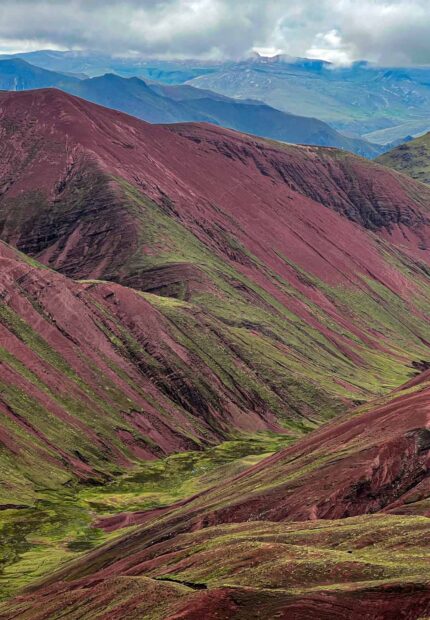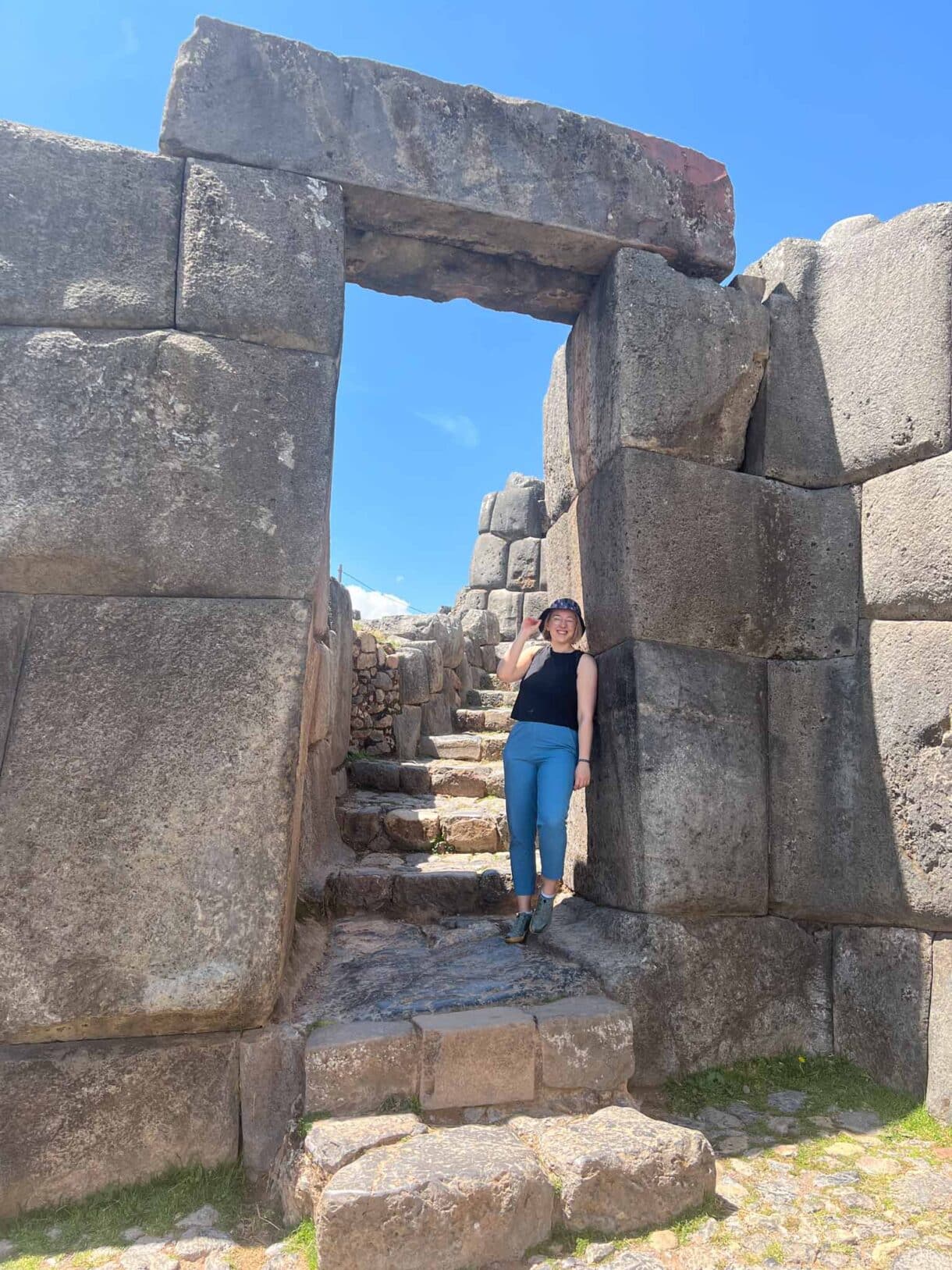
A Complete Guide to Exploring Cusco’s Ruins (without a tour)
So, you’ve just arrived in Cusco and are wondering how to spend your first days in the Sacred Valley as you adjust to the altitude (it’s a woozy 3400m). You might be excited to tick off the many famous ruins; Machu Picchu, Ollantaytambo, Pisac. But don’t forget about the incredible ruins in and around Cusco!
Sacsayhuamán, Q’enko, Pukapukara and Tambomachay are all on the boleto turistico (otherwise known as the Cusco Tourist ticket), and can all be explored in a single day – and without a tour.
So strap on some comfortable shoes and prepare to visit the most important Incan ruins in the greater Cusco region. This itinerary starts and ends in Cusco and can be done entirely by foot and collectivo. For those who have just arrived at altitude, this gentle activity will provide an excellent opportunity to acclimatise.
Keep this map handy!
It’s got all the sites and bus stops bookmarked so you know where to get on and off the collectivo.
WALK TO SACSAYHUAMAN
Sacsayhuaman (hilariously pronounced ‘sexy woman’ by locals and tourists alike) is the largest and most iconic archaeological site in Cusco. History echoes through the massive stone walls and ancient terraces of this massive fortress. Perched high above the city, Sacsayhuaman is a testament to the incredible technology of the Inca civilisation. In fact, scientists still don’t know exactly how the Incas built this feat of engineering.
Normally I’d recommend finishing with the highlight. But getting to Sacsayhuaman first allows you to beat the crowds (and the heat!) as most tour groups arrive later int he morning. As a bonus, you can also buy your boleto turistico here, which you’ll need to get into all four of the ruins in Cusco and on this itinerary.
You can walk to Sacsayhuaman in around 20 to 30 minutes from Cusco’s Plaza de Armas (main square). We’d always recommend walking in Cusco as it helps you to acclimate to the altitude. However, this can be a bit of a shock to the system, especially if you’ve just arrived. If you are not up to a walk or are still adjusting to the altitude, you can choose to get a taxi. There are a number of ‘fake’ taxis operating in town so be sure to check that yours has a licence displayed in the front window as well as their registration number on the rear doors (inside and out).
Note: You may also see Sacsayhuaman spelled Saqsayhuamán, Saqsaywaman or Xacxaguaman. These all refer to the same site!
EXPLORE SACSAYHUAMAN
Once you arrive at Sacsayhuaman and have shown the guard your boleto turistico, you’ll likely be approached by guides offering to show you around. You don’t need a guided tour to enter the ruins, but if you can afford it, hiring a local guide is a little luxury that will enrich your understanding and appreciation of this UNESCO world heritage site. Not to mention, you’ll be supporting local communities too.
For those of you on a budget (like us!), simply say ‘no, gracias’ and head past the guides into the ruins. You’ll want to spend a few hours freely exploring this place. The complex is huge, so schedule several hours for your visit, and bring snacks! If you don’t want to rely on a Wikipedia article (like we did), keep scrolling for a bit about the history of Sacsayhuaman.
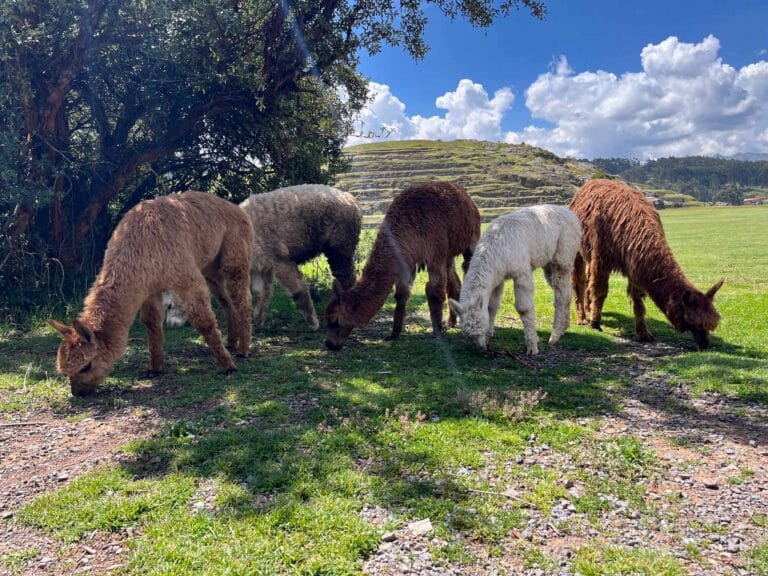
Llamas roaming around Sacsayhuaman
A (VERY BRIEF) GUIDE TO SACSAYHUAMAN
So, you’re looking for a bit about the history of Sacsayhuaman? Well, you won’t have to rely in a wikipedia article like we did, as we’ve collected all the information you need to know right here!
1. HEAD TO THE MAIN ENTRANCE AND BUY YOUR TICKET
Head up the hill from Plaza de Armas to the main entrance and ticket office. Purchase your boleto turistico, and head past the guides through the main gate. As you stand at the entrance, envision how this colossal fortress once served a vital military and ceremonial site during the height of the Inca Empire.
Sacsayhuaman is a Quechua word that means “a place where the hawk is satisfied.” The ruins were likely named this due to the large presence of hawks that make the place home. The site was mainly built (and expanded) by Pachacuti in the 15th century, but the earliest traces of human activity here date back to 900 AD! Perched high above Cusco, this site boasts massive stone walls, intricate masonry, and stunning vistas.
2. STOP AT THE GREAT PLAZA
As you pass through the entrance gate, you’ll step into the Great Plaza. This vast open space was the heart of Sacsayhuaman, hosting grand ceremonies, military parades, and important gatherings during the Inca Empire. Nowadays, it’s a place for school groups and locals to hang out.
In the centre of the plaza, you’ll find an Intihuatana stone, used for astronomical and ritualistic purposes. It’s a symbol of the Inca’s deep connection with the heavens.
This is a really nice place to sit and relax. Sometimes a friendly group of llamas might come to say hello!
3. EXPLORE THE ZIG ZAG TERRACES
Moving forward, you’ll come across the zigzagging terraces. These terraces, which were known as “andenes” or “waru waru”, were used for agriculture and water management to support the population that lived and worked here. The primary purpose of these terraces was to maximize the amount of farming land available for cultivation on hilly terrain. By creating these terraces, the Incas could grow crops at different altitudes, taking advantage of microclimates.
The Incas were excellent agricultural scientists. They developed and cultivated numerous crop varieties, including over 200 types of potatoes, various types of maize (corn), quinoa, and amaranth.
Terraces were used for altitudinal zoning, where they grew different crops at varying altitudes to match the climate and temperature conditions required for specific crops. This allowed them to cultivate a wide range of crops, from potatoes and quinoa at higher altitudes to maize and coca at lower altitudes.
4. WALK BETWEEN THE TOWERING STONE WALLS
As you continue, you’ll be awestruck by the massive stone walls that define Sacsayhuaman. These walls were a remarkable display of Inca architectural skill and an impenetrable defense system against potential invaders. The precision-cut stones fit together seamlessly without mortar, an engineering marvel of the Inca civilization. Scientists still don’t fully understand how the Inca were able to move and lift such stones – the largest weigh up to 120 tons!
5. WANDER THROUGH BUILDINGS OF RELIGIOUS SIGNIFICANCE
As you explore further, you’ll come across altars and ritual spaces. Sacsayhuaman was a place of deep religious importance for the Inca, where ceremonies related to astronomy, agriculture, and spirituality were conducted.
The most important deity in Inca religion was Inti, the sun god. The Inca ruler was believed to be the direct descendent of Inti, and the entire empire’s prosperity was thought to depend on his favour. You can visit the temple of the sun god here! In addition to Inti, the Incas revered Pachamama, the Earth goddess. She was considered the mother of all living things and was associated with fertility, agriculture, and the cycles of nature.
Take a moment to appreciate the stone altars and ceremonial spaces, each with its unique purpose and significance. Observe the enormous carved rock resembling a puma, believed to have held special spiritual importance.
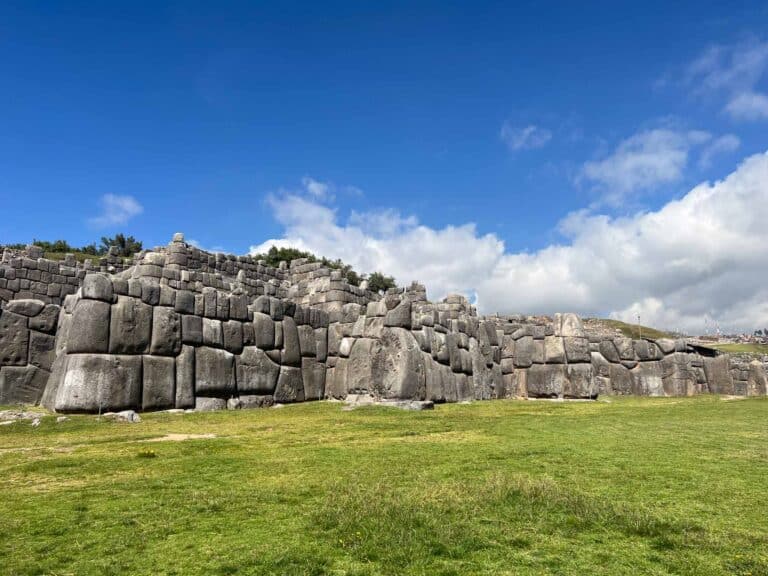
The Incan engineering stands the test of time!
HOP ON A BUS TO TAMBOMACHAY AND PUKAPUKARA
After your loop around Sacsayhuaman, exit at the same entrance you came in by. Head up the hill and pass the statue of Jesus Christ, which looks surprisingly similar to the famous viewpoint in Rio Brazil (just significantly smaller). Take in the views of Cusco, if you haven’t had your fill already! Head through the small park, and down the road until you reach a collectivo stop and catch the next collectivo up the hill. The cost of a 1-way journey was 2 soles. Tell the driver that you want to get off at Tambomachay.
You can also flag down a taxi from the entrance/car park at Sacsayhuaman The going rate for the fifteen-minute journey is around 20 soles. Don’t be surprised if the driver initially quotes you more – just move to the next taxi until you find one that won’t rip you off.
EXPLORE TAMBOMACHAY
Get off the collectivo just before it heads around the corner and head up the cobbled path to explore Tambomachay.
Often referred to as the “Inca Baths,” Tambomachay is a small but perfect site dedicated to water worship. Explore the aqueducts and waterfalls and dip your hands in the clear, cold water that has been flowing for centuries. The water flows through stone fountains and terraces, creating a peaceful and contemplative atmosphere. This site is a testament to the Inca’s profound connection to the natural world.
This particular site shouldn’t require longer than 20-30 minutes to explore. But it’s a tranquil place to relax, enjoy some fresh choclo con queso (corn and cheese) from a local street vendor, and eavesdrop on groups with tour guides.
LOOK OUT FROM PUKAPUKARA
When you’re done exploring Tambomachay, head back on to the main road, cross over, and turn right, walking around 300m to reach Pukapukara. Known for its defensive walls and watchtowers, Pukapukara (meaning “Red Fortress” in Quechua) is a compact archaeological site characterized by its reddish-brown stones. It is believed to have served as a military outpost to guard the road to Cusco and act as a checkpoint for travelers. Climb the walls, explore the buildings, and enjoy the scenic views of the surrounding countryside.
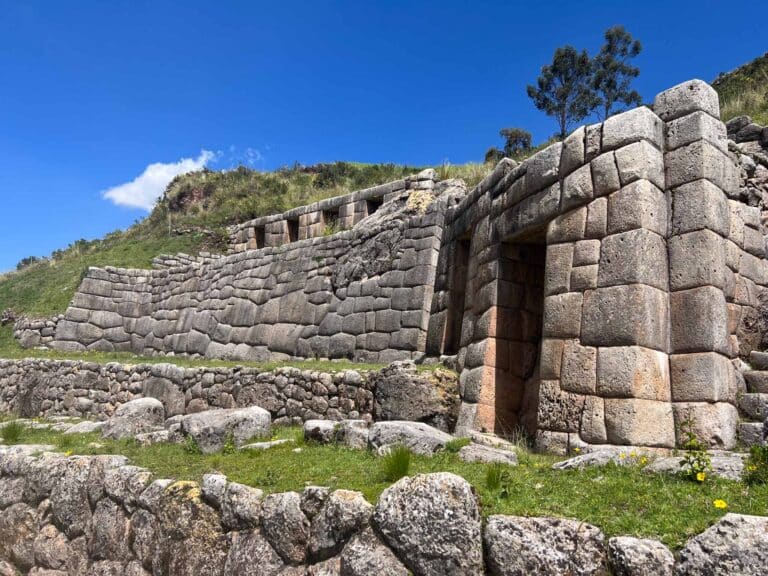
Tambomachay: small but perfect
PREPARE TO BE IMPRESSED AT Q'ENKO
Flag down the next collectivo and get off at Q’enko. The name, meaning “labyrinth” in Quechua, served as an important ceremonial site for the Inca civilization. It’s believed that rituals related to astronomy, agriculture, and mummification took place here.
Full of cool little caves, it’s well worth an exploration, although I did find it a little unsettling that it may have been a site for ritual sacrifices. Look out for the enormous carved rock, resembling a puma, which played a significant role in Inca spirituality. In the afternoon, the site is is beautifully illuminated by the changing light, which only adds to the vibes of this site.
GETTING BACK TO CUSCO…
… is easy! Leave Q’enko and walk down the main road. Eventually, you’ll come to a steep staircase continuing down through a residential area. Keep heading down, and you’ll come out in Cusco’s San Blas neighbourhood – the perfect place to stop for some delicious local food or incredible £3/$4 falafel at San Blas Market (yes, I went to this market almost every day, yes I ordered the same falafel every time, no I do not have any regrets)
PRACTICAL TIPS FOR YOUR SELF-GUIDED ADVENTURE
- Tickets: To visit these ruins, you’ll need a Cusco Tourist Ticket (Boleto Turistico), which allows entry to multiple archaeological sites in the Cusco region. You can purchase these tickets at the Cusco Tourist Information Center or at the entrance of some of the sites.
- Weather: Be prepared for changing weather conditions. Cusco’s altitude can result in quick temperature shifts, so dress in layers and carry rain gear.
- Footwear: Wear comfortable walking shoes with good grip, as some areas may be steep or uneven.
- Water and Snacks: Bring a reusable water bottle and some snacks to keep you energised throughout your exploration.
- Respect the Sites: Show respect to these ancient sites! Don’t climb on the walls or walk where you’re not supposed to. Don’t touch carvings. And remember to take your rubbish home or throw it away (in a bin, not on the floor)
Exploring Cusco’s ruins without a tour can be a deeply rewarding experience, allowing you to connect more intimately with the history and culture of this remarkable region. So, lace up your hiking boots, pack your sense of adventure, and embark on a self-guided journey through the captivating ruins of Sacsayhuaman, Q’enko, Tambomachay, and Puca Pucara. Each step you take will be a step back in time, revealing the mysteries of the Inca civilization. Enjoy your adventure!
Follow our daily adventures on Facebook and Instagram
Disclaimer: The information and advice provided in this blog are the author’s opinions and based on their personal experiences. All information was accurate at the time of writing. However, things can change quickly, so always double-check current conditions and guidelines before setting out. Remember, your travels and safety are your own responsibility, and this blog can not be held responsible for anything that might happen on your adventures! Always exercise caution and good judgment. Oh, and don’t forget to get travel insurance! Happy travels!
This post may contain affiliate links (yay for transparency!) This means that I will earn a small commission, at no additional cost to you, if you click the link and choose to buy the product. I only link to stuff I have personally bought and found useful and never endorse crap. Your support helps keep the site going, thank you!
Alice
Alice is a UK travel blogger who advocates sustainable travel and being more eco-conscious on a budget. She loves coffee, her houseplants and summiting mountains.
You May Also Like

Sip, Savor, and Explore: The Best Coffee Shops in Cusco
September 9, 2023